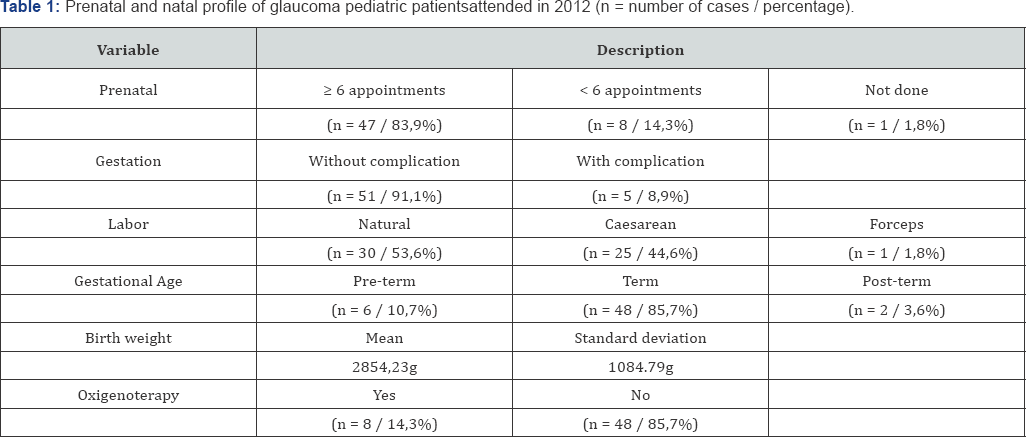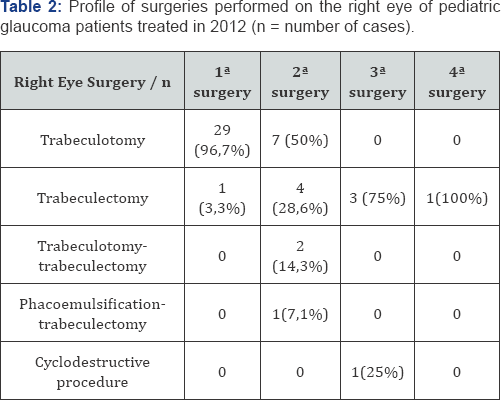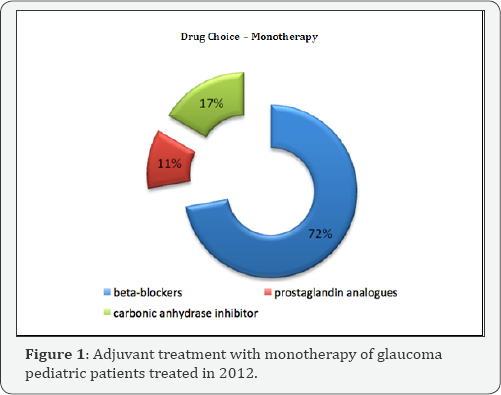Epidemiological Profile of Patients with Congenital Glaucoma from a Brazilian Tertiary Eye Care Center
Hévila Rolim12*, Ana Flávia Lacerda Belfort3 , Hayana Marques do Aragão Rangel2, Gabriella de Alencar Costa Shigetomi2, Marcos Massato Hirahata2 and Wagner Duarte Batista2
1Medicine College, Universidade Federal de Rondonia, Brazil
2GIaucoma and Cataract Reference Center, Santa Casa de Belo Horizonte, Brazil
3Department of Ophthalmology, Santa Casa de Belo Horizonte, Brazil
Submission: November 30, 2017; Published: December 18, 2017
*Corresponding author: Hévila Rolim, Depto de Medicina- UNIR Campus José RibeiroFilho BR 364km 9,5 Bloco 2C, Sala 212- CEP 76801-059 - Porto Velho - RO - Brazil, Tel: +55(69)98129-7511; Email: hevilarolim@unir.br
How to cite this article: Hevila R, Ana F L B, Hayana M d A R, Gabriella d A C S, Marcos M H et.al. Epidemiological Profile of Patients with Congenital Glaucoma from a Brazilian Tertiary Eye Care Center. JOJ Ophthal. 2017; 6(1): 555678. DOI: 10.19080/JOJO.2017.06.555678
Abstract
Introduction: Pediatric glaucoma is a rare disease, however contributes as an important treatable cause of blindness in childhood, representing 5% of all causes of pediatric blindness
Methods: Medical records from patients treated during a year (2012) at the Pediatric Glaucoma Department at the Cataract and Glaucoma Reference Center of Santa Casa Hospital in Belo Horizonte were analyzed. Demographic, clinical diagnosis and therapeutic data were evaluated.
Results: 56 charts were analyzed, with a majority of male patients (58.9%) and mean age of 4.29 years. In all, 28.6% had family history of glaucoma and only one (1.8%) had a family history of primary congenital glaucoma. Treatment was essentially surgical in 40 patients (71.4%) and clinical treatment with antiglaucomatous eye drops was prescribed in 37 cases (66.1%).
Discussion: The data obtained in this epidemiological profile provide a unique perspective of pediatric glaucoma patients treated in apublic tertiary eye care center from the Brazilian State Healthcare system (SUS). The patients were mostly from small towns in the countryside, reflecting the precariousness of the Brazilian health system far from the capitals.
Conclusion: The epidemiological study of pediatric glaucoma should be routinely evaluated because although rare, this type of glaucoma remains one of the main causes of blindness in childhood which needs early diagnosis and effective treatment to minimize the impact on vision.
Keywords: Pediatric glaucoma; Congenital glaucoma; Epidemiology; Pediatric ophthalmology
Introduction
Pediatric glaucoma is a rare disease, with primary congenital glaucoma (PCG) being the most common type of glaucoma in childhood and an important cause of blindness, with an average incidence of 1: 10,000 births. However, in some populations, due to consanguineous marriages, this incidence is higher, as in Saudi Arabia (1: 2,500), and Romanian Gypsies (1: 1,250). Most cases are sporadic, but 10% to 40% are of family origin, with a generally autosomal recessive transmission. The disease is usually bilateral in 65% to 80% of cases; and occurs more frequently in males (3: 2) [1,2].
It appears frequently before the age of three years, characterized by elevated intraocular pressure (IOP) at birth or in childhood, corneal edema, enlarged eyeball (buphthalmos), corneal enlargement, Haab'sstriae and damage to the optic nerve . It can be divided into primary and secondary. The elevation of IOP in congenital glaucoma is secondary to the abnormal development of the ocular anterior segment, that results in impairment of aqueous humor drainage. The development of the anterior chamber angle occurs from the cells of the neural crest, but there is no consensus as to the nature of the abnormalities that compromise it [3,4].
The treatment of congenital glaucoma is essentially surgical, through trabeculotomy and goniotomy, and in refractory cases trabeculectomy, drainage devices and cyclodestructive procedures. The clinical treatment is used as adjuvant [3]. In Brazil, there are few studies in the literature evaluating the epidemiological profile of congenital glaucoma, motivating this study.
Methods
The study was conducted in accordance with national and international resolutions on ethics and good clinical practice. All data obtained in the study were kept confidential and only accessed by the researchers involved in the project. The retrospective study analyzed charts of patients treated in 2012 at the congenital glaucoma department at the Cataract and Glaucoma Reference Center of Santa Casa Hospital in Belo Horizonte. Demographic, clinical diagnosis and therapeutic data were evaluated. Congenital glaucoma was defined as IOP> 21 mmHg associated with signs of buphthalmos, increased corneal diameter (greater than 11 mm in newborns and 12 mm in infants), corneal edema, Haab striae, increased axial diameter, or large optic nerve cupping. Primary congenital glaucoma was characterized bya developmental defect that affects only the trabecular meshwork and secondary when there was association with other ocular and systemic abnormalities. Racial classification was self-declared and segmented according to criteria of the Brazilian Institute of Geography and Statistics (IBGE) [5].
To plot the sample, frequency tables were constructed with the number of occurrences and their respective percentages for the categorical variables and the mean (median and median) and variability (standard deviation) measures for the quantitative variables were calculated. Clinical data were analyzed statiscally using SPSS version 19.0 for Windows (SPSS Inc., Chicago, IL, USA).
Results
We analyzed 56 charts: 33 patients were male (58.9%), with mean agenof 4.29 years (standard deviation=2.89) and39 cases (69.6%) were bilateral. According to self-declared ethnicity, six (10.7%) were considered blacks, thirteen (23.2%) whites and 37 children (66.1%) were intermediate ("pardos"). Most of the patients were from the small towns of Minas Gerais State (n = 34 / 60.7%). The majority of patients did not present complications during the prenatal and natal periods (Table 1).

In patients with congenital glaucoma, it is essential to investigate personal and family history. Sixteen (28.6%) cases had isolated comorbidities such as renal tubular acidosis, auditory alteration, aniridia, motor development delay, bronchospasm, congenital cataract, upper limb hemangioma, facial hemangioma, intracranial hemorrhage, perinatal infection, nevus flameus, ocular perforation, tetralogy of Fallot and vitiligo. In all, sixteen children (28.6%) had a family history of glaucoma and only one (1.8%) had a family history of PCG. Consanguinity was present in only one (1.8%) case.
Patients diagnosis were divided in primary (n=38 / 67.9%) and secondary (n=3 / 5.4%) congenital glaucoma. In 15 children (26.8%) with glaucoma suspicion, diagnosis was excluded after propaedeutics. The treatment was essentially surgical and 40 patients (71.4%) were operated on, being trabeculotomy the procedure of choice in both first and second surgeries (Table 2 & 3). Only one patient with congenital glaucoma had not undergone surgery by the end of 2012 because he was from a small town in the countryside and did not perform the preoperative clinical exams.




The clinical treatment with antiglaucomatous eye drops was prescribed in 37 cases (66.1%) as an adjuvant. Eighteen cases (48.6%) were treated in monotherapy and 19 cases (51.4%) with drug combinations. In monotherapy, beta-blockers were used in 13 cases; two cases used prostaglandin analogues and three cases carbonic anhydrase inhibitors (Figure 1). The most used combination was beta blocker with carbonic anhydrase inhibitor in ten (53%) patients (Figure 2). In eight patients with congenital glaucoma (14.3%), unilateral amaurosis was diagnosed.
Discussion
The data obtained in this epidemiological profile provide a unique perspective of patients treated in a public tertiary eye care center from the Brazilian State Healthcare system (SUS) which is one of the Brazilian reference centers in pediatric glaucoma.
Male prevailed in the sample in agreement with the literature second Aponte et al. [6]. Based on self-declared skin color, Intermediates ("pardos") were more prevalent (66.1%) than their share in the Brazilian populationwhere 47.7% were selfclassified as White (IBGE-2010). Rolim et al. (2016) found an increase in African ancestry in PCG patients that was associated with a high number of surgeries to control IOP and higher ocular globe growth which suggests that ancestry can influence the prognosis of the disease. The African ancestry component appears to influence PCG algorithms, perhaps acting as a risk factor when present in high proportion [7].
The patients attended were mostly from small towns, reflecting the precariousness of the Brazilian health system far from the capitals and the absence of professionals with subspecialities in these places. There is a low incidence of positive family history of congenital glaucoma and inbreeding in this study. Kipp reported 10% of cases of PCG with predominantly recessive family inheritance; being the sporadic cases majority [4]. This study differs from Stoilov et al. [9] that in 52 brazilian PCG patients analyzed, 51.9% had a family history of glaucoma and 26.9% consanguinity [7]. The reason for this difference remains to be established.
In agreement with published studies, PCG is the most common type of glaucoma in childhood. According to Ho & Walton [1] disease is bilateral in 65-80% of cases; results also observed in this study (69.6%) [1]. Treatment is essential to prevent glaucoma progression that impacts visual acuity and visual field. Trabeculotomy and goniotomy are the most commontypes ofsurgical procedures in childhood glaucoma, with success of 80-90% when the disease presents between one and 24 months of age, corroboring our data.In the refractory cases, trabeculectomy, drainage implant and cyclodestructive procedures can be performed [3,7,8,10]. First choice of medication the beta-blockers wich act decreasing the production of aqueous humour by the ciliary processes and are prescribed to maximize IOP reduction after surgical treatment, corroborating previous data [3,6,8].
In the treatment of pediatric glaucoma, IOP control is not the only goal; the treatment of amblyopia in these patients is also essentialto improves visual prognosis. Moore et al. [8] confirmed the importance of early diagnosis and treatment of this disease since PCG represents 5% of pediatric blindness.8In Brazil, there are few statistical studies regarding the pediatric glaucoma patient profile. The epidemiological study of this disease should be routinely evaluated in order to know variations, in terms of prevention and treatment; because although rare, this type of glaucoma remains one of the main causes of childhood blindness which needs early diagnosis and effective treatment.
Conflict of Interest
The authors declare no conflict of interest.
References
- Ho CL, Walton DS (2004) Primary congenital glaucoma: 2004 update.J Pediatr Ophthalmol Strabismus 41(5): 271-288.
- Bejjani BA, Lewis RA, Tomey KF (1998) Mutation in CYP1B1, the gene for cytochrome P4501B1, are the predominant cause of primary congenital glaucoma in Saudi Arabia. Am J Hum Genet 62(2): 325-333.
- Hoskins HD Jr., Shaffer RN, Hetherington J (1984) Anatomical classification of the developmental glaucomas. Arch Ophthalmol 102(9): 1331-1336.
- Kipp MA (2003) Childhood glaucoma. Pediatr Clin N Am 50(1): 89-104.
- Instituto Brasileiro de Geografia e Estati'stica. Censo demografico 2010.
- Aponte EP, Diehl N, Mohney BG (2010) Incidence and Clinical Characteristics of Childhood Glaucoma: A Population-Based Study. Arch Ophthalmol 128(4): 478-482.
- Rolim H, Cronemberger S, Rangel H, Batista W. D, Bastos-Rodrigues L, et al. (2016) The role of Genetic Ancestry in Brazilian patients with Primary Congenital Glaucoma. J Glaucoma 25(1): e24-e28.
- Moore DB, Tomkins O, Ben-Zion I (2013) A Review of Primary Congenital Glaucoma in the Developing World. Surv Ophthalmol 58(3): 278-285.
- Stoilov IR, Costa VP, Vasconcellos JPC, Melo MB, Betijane AJ, et al. (2002) Molecular Genetics of Primary Congenital Glaucoma in Brazil. Invest Ophthalmol Vis Sci 43(6): 1820-1827.
- Papadopoulos M, Cable N, Rahi J, Khaw PT (2007) The British Infantile and Childhood Glaucoma (BIG) Eye Study. Invest Ophthalmol Vis Sci 48(9): 4100-4106.
- Dimasi DP, Hewitt AW, Straga T, Pater J, MacKinnom JR, et al. (2007) Prevalence of CYP1B1 mutations in Australian patients with primary congenital glaucoma. Clin Genet 72(3): 255-260.
- Alanazi FF, Song JC, Mousa A, Morales J, Shahwan SAL, et al. (2013) Primary and Secondary Congenital Glaucoma: Baseline Features From a Registry at King Khaled Eye Specialist Hospital, Riyadh, Saudi Arabia. Am J Ophthalmol 155(5): 882-889.






























